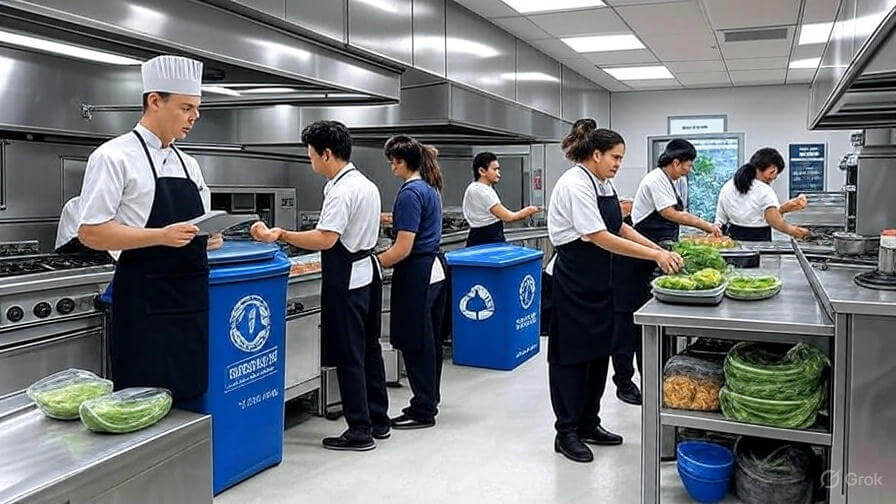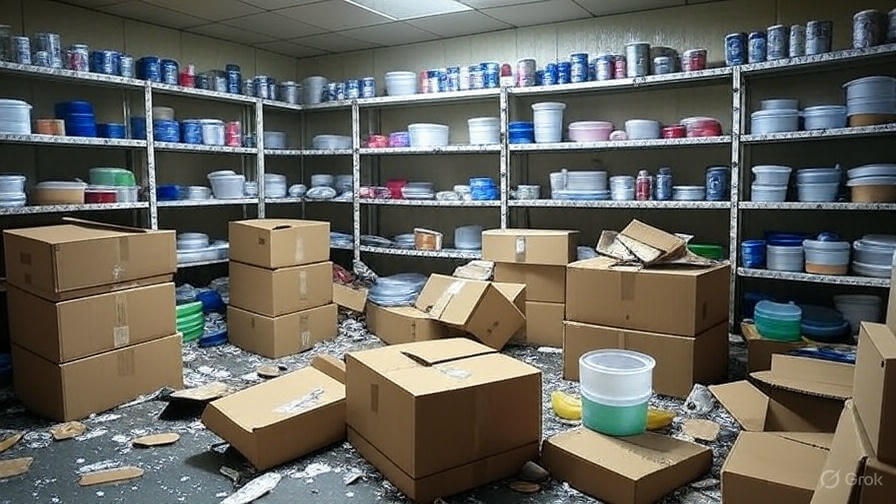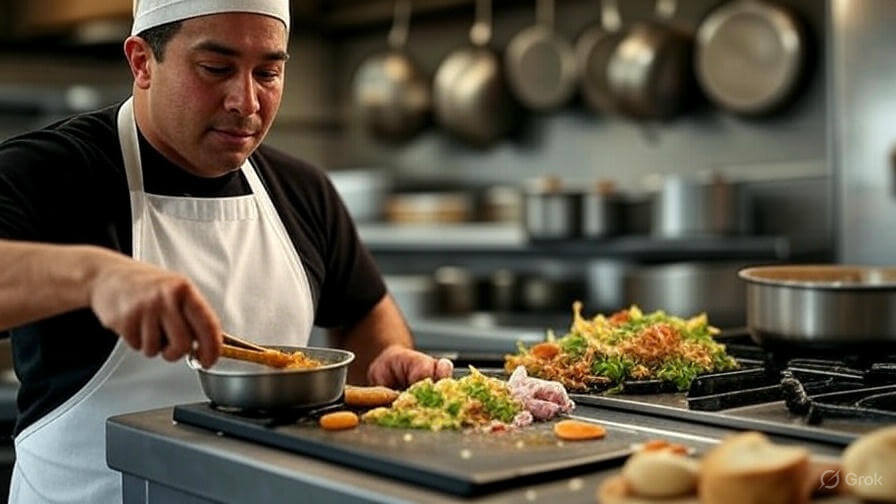
Cut Food Waste in Restaurants: Boost Profits & Enhance Sustainability
Ever wondered how many perfectly good ingredients end up in the trash at your favorite restaurant? 🌍 That’s the harsh reality of food waste in restaurants—where 40% of all food produced gets tossed, costing businesses a staggering $100 billion yearly. This guide reveals how to reduce food waste in restaurants, from inventory management to menu engineering, to slash costs and boost restaurant sustainability. 🌱 Dive in to uncover how waste reduction strategies can turn your kitchen into a lean, eco-friendly powerhouse—saving money while serving the planet.
Article key takeaways
Table of contents
- Smart Inventory Management to Minimize Food Waste
- Menu Engineering and Kitchen Practices for Waste Reduction
- Beyond the Kitchen: Comprehensive Waste Management Solutions
- Global Food Waste Key Figures
Smart Inventory Management to Minimize Food Waste
« The most valuable lesson of the Italian kitchen is to never throw anything away: no crumbs or bones ever get thrown in the bin. »
— Massimo Bottura, Chef of Osteria Francescana
Tracking Ingredients to Prevent Overstocking
Inventory systems track ingredients and prevent overstocking through real-time monitoring. 📊 Weekly counts identify spoilage risks while FIFO rotation ensures older stock gets used first. Also, technology like barcode systems and cloud-based platforms automate tracking. Restaurants cut waste by syncing orders with sales data and seasonal menu changes. Smart inventory practices slash 25% waste in 6 months with proper staff training.

Optimizing Storage and Data Insights
Optimize food storage with these practical strategies to extend shelf life and reduce waste:
- Maintain optimal temperatures 🌡️: Keep refrigerators at 40°F (4°C) or below and freezers at 0°F (-18°C) for long-term preservation
- Implement FIFO system 🔄: Rotate stock daily to use older ingredients first and prevent expiration
- Label everything clearly 📝: Mark containers with item names, preparation dates, and expiration dates
- Use airtight containers 🍽️: Store dry goods in sealed containers and liquids in leak-proof containers to prevent contamination
- Prevent cross-contamination 🚫: Separate raw meats (store on bottom shelves), ready-to-eat foods (top shelves), and vegetables (middle shelves)
- Control humidity & airflow 💨: Store produce in high-humidity drawers and dry goods in ventilated areas with 50-60% humidity
- Sanitize storage areas weekly 🧼: Clean shelves, containers, and equipment regularly to maintain food safety and quality
These storage practices significantly cut food waste while ensuring ingredient freshness and safety.
Analyzing inventory data improves purchasing decisions by revealing sales patterns and seasonal trends. 📈 Restaurants also needs to track ingredient usage against menu items to adjust orders. Data shows which dishes drive waste and when to buy local produce. Seasonal menus reduce storage needs while connecting with community farmers. The consequence is that restaurants generally save $1 for every $7 invested through smarter data-driven ordering.
Menu Engineering and Kitchen Practices for Waste Reduction
« Where my friend saw nothing, I saw possibility. »
— Steven Satterfield, From his cookbook Root to Leaf
Strategic Menu Design to Minimize Waste
Smart menu design significantly reduce food waste in restaurants by using ingredients across multiple dishes. 🍅 Roasted tomatoes can star in omelets, soups, and pastas. This cross-utilization slashes costs while maintaining flavor variety. Simple ingredient sharing between menu items reduces inventory complexity and keeps waste off the plate.
Offering portion flexibility reduces waste by 30%. 🍽️ Tokyo’s “small/large” omelet options and Parisian half-pizza + salad combos show how. Track plate waste – 25% of fries and 15% of salads often go uneaten. Adjust portions to match customer appetite patterns and seasonal demand to significantly reduce food waste in restaurants.

Kitchen Prep and Cooking Techniques
Chefs transform scraps into profits. 🥕 Carrot tops become chimichurri, fish bones stock, and stale bread becomes croutons. Simple prep adjustments maximize ingredient use while maintaining quality and safety.
- Turn vegetable peels into broths 🥣
- Use citrus zest before juicing 🍋
- Repurpose trimmings into stocks and sauces 🥣
- Transform overripe fruits into desserts 🍌
- Use whole animals/vegetables when possible 🐷
- Make sauces from cooking liquids 🥄
- Repurpose day-old bread into breadcrumbs 🍞
Proper cooling extends shelf life. 🔥 Flash-chill hot foods to 40°F within 2 hours. Vacuum-seal proteins at 40°F max. Avoid the « danger zone » (40-140°F) where bacteria thrive. Correct storage prevents 9 tons of annual waste per restaurant.
| Role | Waste Tracking | Reduction Actions |
|---|---|---|
| Chef | Oversees waste audits, reviews inventory data | Redesigns menus, trains team on waste practices |
| Prep Cook | Records trim waste daily | Repurposes scraps into stocks, sauces |
| Server | Monitors plate waste | Recommends portion options, promotes doggy bags |
| Manager | Tracks monthly waste metrics | Optimizes ordering, implements staff incentives |
Building a Waste-Conscious Team Culture
Training transforms staff into waste warriors. 🧑🍳 Monthly workshops, like knife-skills trainings, show how $1 invested = $7 saved through waste reduction. Incentives like « Waste Warrior of the Month » spotlight top performers. Assign clear responsibilities using our table above – when everyone owns their role, restaurants cut waste by 25% in 6 months. Simple practices become powerful when teams unite for sustainability. 🌱
Tracking Waste & Sharing Solutions
Communication systems turn waste tracking into action. 📊 Digital apps like Too Good To Go let teams log waste in real-time. Daily waste logs identify problem areas (spoiled ingredients, overproduction). Weekly 15-minute stand-ups share insights – « Yesterday we saved 12 carrots by adjusting veggie prep! » Quarterly celebrations highlight progress – when staff see 2.8 tonnes/year saved, they stay motivated. 🎉
Measure what matters: track weekly waste by category (prep, plate, spoilage), monthly cost savings, and annual diversion from landfills. 📈 For 1.5M tonnes wasted yearly in France, small changes add up. Share metrics visually – chalkboards in kitchens show progress toward EU 2030 targets. Recognition matters – the Anti-Waste Label rewards restaurants reducing food loss by 50%. When teams see impact, they create magic. ✨
Beyond the Kitchen: Comprehensive Waste Management Solutions
« We need to harness the significance of people’s obsession with food right now, and understand how waste is sinful, criminal, as well as financially foolish. »
— Mario Batali, From the documentary Wasted!
Collaborating with Local Partners
Partnering with local farms enables just-in-time deliveries 🚚 and flexible orders. Restaurants ordering daily from regional producers cut storage needs by 14% ⏳. France’s 1.4M tonnes/year from commercial catering shows why local ties matter. Smaller, fresher batches mean less spoilage before food even hits the kitchen. No more guessing games with inventory!
Buying « ugly » produce saves 40% of global fruits/veggies that get discarded for looks 🥕. Bulk purchasing reduces packaging waste by 56% 📦. France’s “Quoi ma gueule?” campaign proves wonky fruits sell well. Suppliers now offer compostable packaging – some restaurants use 100% recyclable containers 🌱. Collaborate for mutual benefits: less waste, stronger local economy.

Engaging Customers in Waste Reduction
Turn patrons into waste warriors! 🎯 France’s 39% consumer waste stats mean guests want solutions. Offer solutions reduce plate waste by 30%. Simple signage like “Your leftovers deserve love too” makes waste reduction fun, not preachy.
Menus with portion icons (small/regular/large) cut waste by 25% 📊. Servers trained to say “Try our half-portion?” save 211g/meal 🍽️. France’s 230g/meal saved through doggy bags proves customers respond. Visual cues like “Chef’s Special: Made from scraps” build curiosity without sounding eco-preachy. Balance education with enjoyment – nobody likes a guilt trip!
Waste That Can’t Be Prevented
Composting turns scraps into black gold. 🌱 France’s restaurants produce 9 tonnes/year of unavoidable waste. Onsite composters work for kitchens with gardens. Others use collection services – some even pay you! Partner with urban farms for nutrient-rich soil. Every ton diverted avoids landfill methane – better for Earth than burying cash in the trash.
Donate surplus food safely using EU guidelines 📦. France’s 66.5M meals donated in 2021 show it’s doable. Follow temperature rules (keep cold foods below 41°F), document donations, and use food rescue groups. Liability protections exist – France’s law even offers tax incentives. The hungry need your excess, not your expired stock. Turn would-be waste into community wins 🤝.
Turning food waste into opportunity starts with smart inventory 📊, creative menus 📋, and engaged teams 👨🍳. Small shifts today slash costs tomorrow—imagine fresher ingredients, happier customers, and a lighter environmental footprint 🌍. The future of dining? Less waste, more taste—yours to shape.
Global Food Waste Key Figures
« It’s obscene that we’re dumping knowingly, or through neglect, 40% of our total food production straight into the garbage. »
— Anthony Bourdain, Chef, writer, and documentarian
The Alarming Scale of Restaurant Food Waste
Restaurants worldwide toss 1.3 billion tons of food yearly, costing $100 billion 🤯. In the EU alone, 15 kg per person gets wasted annually from foodservice, creating methane in landfills 🌍. The hospitality industry’s food waste generates 16% of EU food-related greenhouse gases – more than all cars globally! (source) This rotting food could feed 50 million people yearly if redirected.
Food waste occurs at every stage: 12% in purchasing (overbuying), 14% in storage (spoiled ingredients), 11% in prep (trimmings), and 13% at customers’ plates 🍽️. These losses slash profit margins – wasted ingredients represent 6% of restaurant costs. For a 300-meal/day cafeteria, this equals $13,000 in annual losses. The hospitality industry’s $682 million UK losses show why waste reduction must become kitchen priority #1.
Why Restaurants Should Prioritize Waste Reduction
Food waste isn’t just bad for profits – it’s disastrous for our planet 🌎. Those 1.3 billion wasted tons create methane emissions equivalent to 330 million cars yearly! The EU’s 2030 target demands 50% reductions industry-wide (source). In France, 9.4 million tonnes wasted yearly equals 33 Eiffel Towers of food hitting landfills – and your restaurant could be part of the solution.
Modern diners care deeply about sustainability – 75% prefer eco-conscious restaurants! 🧑🍳 When you reduce waste, you’re not just saving money – you’re building loyalty. Today’s customers notice portion sizes, composting efforts, and anti-waste innovations. Simple changes like doggy bags or creative use of scraps can turn your kitchen into a customer magnet while saving 211g/meal in consumer waste. Sustainability isn’t just good for Earth – it’s great for business.
Food waste reduction is a part of eco friendly practices in hotel industry. In this case, these practices will be integrated in your hotel environmental policy.
Q/A Reduce Food Waste in Restaurants
How to accurately track food waste?
Alright, tracking food waste in restaurants? It’s all about measuring those losses at every stage, from delivery to doggy bags. Weighing different types of waste—spoiled goods, prep scraps, plate leftovers—is key. You can do it manually or use fancy connected scales.
Don’t forget to analyze the « why. » Too much prep? Bad stock management? Tech solutions like AI can help identify and estimate waste with cameras. Getting the staff involved is essential, too. Alternatively to technologic options, we have a relevant and affordable solution to cut food waste in restaurants.
How to involve suppliers in the process?
To get suppliers on board with reducing food waste, start by automating orders. Softwares can help restaurants order just the right amount of ingredients based on sales forecasts. Also, work closely with suppliers to adapt delivery quantities to your restaurant’s actual needs.
Suppliers can also help with managing expiration dates and offering suitable packaging. Establish partnerships for recovering unsold or wasted food through composting or donations. It’s all about teamwork to reduce food waste in restaurants! 🤝
How to reuse used cooking oil?
Reusing used cooking oil? Restaurants are legally responsible for their waste fats. Instead of tossing it, valorize it and transform it into next-gen biofuels. Companies like Veolia and Allo à l’huile offer collection services. They give you containers, collect the oil, and ensure traceability. Some even buy the oil from you!
The collected oils are treated, filtered, and transformed into biofuel. It’s a win-win: you get rid of waste responsibly, and it becomes something useful. The law requires restaurants to handle used oil carefully and ensure its proper disposal through recycling. 🛢️
How to reduce food waste in restaurants ‘ buffet?
Managing waste in a buffet is all about reducing waste while keeping customers happy. Adjust the amounts prepared based on attendance and eating habits. Use leftovers in other dishes, and offer smaller portions to encourage refills.
Inform customers about food waste issues and consider disincentives, like charging extra for excessively full plates. Partner with apps like Too Good To Go to offer discounted anti-waste baskets. Analyze returned plates to adjust your offerings and avoid overstocking. 🍽️
